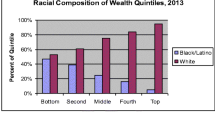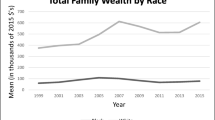Abstract
Prior research has found evidence of large racial and gender disparities in wealth, with blacks possessing less wealth than whites and women having less wealth than men. An intersectionality approach suggests that the overlapping impacts of racial and gender domination are likely to combine in a multiplicative fashion that places black women in a uniquely precarious economic position. However, little is known about the wealth holdings of black women and even less is known about whether their wealth increases, decreases or remains stable as they approach retirement age, a stage of life when savings are especially important. This study utilizes seven waves of panel data from the Health and Retirement Study (HRS) and growth curve models to estimate the wealth trajectories of black women between the ages of 51 and 73. Results reveal that black women have especially low levels of net worth and net financial assets during middle and late life, suggesting high risk of economic insecurity in later life. Consistent with political economy and intersectionality perspectives, their persistently low wealth trajectories are likely the result of state policies, discrimination, residential segregation and health disparities. Ameliorative policy prescriptions are discussed.



Similar content being viewed by others
References
Altonji JG, Doraszelski U. The role of permanent income and demographics in black/white differences in wealth. J Hum Resour. 2005;40(1):1–30.
Andersen ML, Collins PH. Race, class, and gender. An anthology. 2nd ed. Belmont: Wadsworth Publishing Company; 1995.
Ariel/Hewitt. 401 (k) Plans in living color: a study of 401 (k) Savings Disparities Across Racial and Ethnic Groups. Accessed May 15, 2011, from http://www.arielinvestments.com/images/stories/PDF/arielhewittstudy_finalweb_7.3.pdf
Avery RB, Brevoort K, Canner GB. Higher-priced home lending and the 2005 HMDA data. Fed Reserv Bull. 2006;92:A123–66.
Ayres I. Further evidence of discrimination in new car negotiations and estimates of its cause. Mich Law Rev. 1995;94(1):109–47.
Ayres I, Siegelman P. Race and gender discrimination in bargaining for a new car. Am Econ Rev. 1995;85:304–21.
Azpitarte F. Measuring poverty using both income and wealth: a cross-country comparison between the U.S. and Spain (ECINEQ Working Paper, No. 2010–153). Palma de Mallorca: Society for the Study of Economic Inequality; 2010.
Bishaw A, Semega J. U.S. Census Bureau, American Community Survey Reports, ACS-09, income, earnings, and poverty data from the 2007 American Community Survey. Washington, DC.: U.S. Government Printing Office; 2008.
Blossfeld H, Hakim C. Between equalization and marginalization. New York: Oxford University Press; 1997.
Brady D. Rich democracies, poor people: how politics explain poverty. New York: Oxford University Press; 2009.
Brewer RM. Theorizing race, class and gender: the new scholarship of black feminist intellectuals and black women’s labor. In: James SM, Busia APA, editors. Theorizing black feminisms: the visionary pragmatism of black women. London: Routledge; 1993. p. 13–30.
Brown TH, Warner DF. Divergent pathways: racial/ethnic differences in women’s labor force withdrawal. J Gerontol B Psychol Sci Soc Sci. 2008;63B(3):S122–34.
Brown TN. Critical race theory speaks to the sociology of mental health: mental health problems linked to racial stratification. J Health Soc Behav. 2003;44(3):292–301.
Carrington WJ, Troske TR. Interfirm segregation and the black/white wage gap. J Labor Econ. 1998;16:231–60.
Chang ML. Shortchanged: why women have less wealth and what can be done about it. NY: Oxford University Press; 2010a.
Chang, ML. Lifting as we climb: women of color, wealth, and America’s future. Insight Center for Community Economic Development; March 2010b. Accessed March 1, 2011, from http://www.insightcced.org/uploads/CRWG/LiftingAsWeClimb-InsightCenter-Spring2010.pdf
Cherlin AJ. Marriage, divorce, remarriage. Cambridge: Harvard University Press; 1992.
Chiteji NS, Hamilton D. Family connections and the black-white wealth gap among middle-class families. Rev Black Polit Econ. 2002;30(1):9–28.
Christie-Mizell CA. The effects of traditional family and gender ideology on earnings: race and gender differences. J Fam Econ Issues. 2006;27(1):48–71.
Christie-Mizell CA, Keil JM, Kimura A, Blount SA. Gender ideology and motherhood: the consequences of race on earnings. Sex Roles. 2007;57:689–702.
Collins PH. Black feminist thought: knowledge, consciousness, and the politics of empowerment. New York: Routledge; 2000.
Conley D. Being black, living in the red: race, wealth, and social policy in America. Berkeley: University of California Press; 1999.
Conrad DA, Brown LN. 2011. The impact of macroeconomic fluctuations on the likelihood of African American female home ownership. Paper presented at the Invisible Women’s Conference: The Status of and Challenges Facing Black Women. Guilford College, Greensboro, NC on March 19, 2001.
Crenshaw K. Demarginalizing the intersection of race and sex: a black feminist critique of antidiscrimination doctrine, feminist theory, and antiracist politics. University of Chicago Legal Forum; 1989. p. 139–167.
Darity WA. Forty acres and a mule in the 21st century. Soc Sci Q. 2008;89(3):656–64.
Darity WA, Mason PL. Evidence on discrimination in employment: codes of color, codes of gender. J Econ Perspect. 1998;12:63–90.
Davis AY. Women, race, and class. New York: Random House; 1981.
Dawson M, Popoff R. Justice and greed: black and white support for reparations. DuBois Rev. 2004;1(1):47–91.
Delgado R, Stefancic J. Critical race theory: an introduction. New York: New York University Press; 2001.
FDIC. National survey of unbanked and underbanked households; 2009. Accessed May 15, 2011, from http://www.fdic.gov/householdsurvey/full_report.pdf
Fellowes M. From poverty, opportunity: putting the market to work for lower income families—Brookings institution; 2006. Accessed March 9, 2011, from http://www.brookings.edu/reports/2006/07poverty_fellowes.aspx
Flippen C. Unequal returns to housing investments?: a study of real housing appreciation among black, white, and Hispanic households. Soc Forces. 2004;82:1523–51.
Fuchs VR. Women’s quest for economic equality. J Econ Perspect. 1989;3(1):25–41.
Friedman M. Capitalism and freedom. Chicago: University of Chicago Press; 1962.
Gittleman M, Wolff EN. Racial differences in patterns of wealth accumulation. J Hum Resour. 2004;39(1):193–227.
Glaeser E, Vigdor J. Racial segregation in the 2000 census: promising news. Washington, D.C.: Brookings Institution; 2001.
Goldin C. Understanding the gender gap: an economic history of American women. New York: Oxford University Press; 1990.
Hamilton D, Darity W. Can ‘Baby Bonds’ eliminate the racial wealth gap in putative post-racial America? Rev Black Polit Econ. 2010;37:207–16.
Hardy MA. Regression with dummy variables. Sage University paper series on quantitative applications in the social sciences. Newbury Park: Sage; 1993. p. 07–093.
He W, Sengupta M, Velkoff VA, Debarros K. 65+ in the United States: 2005. U.S. Census Bureau, Current Population Reports, P23—209. U.S. Government Printing Office, Washington, DC; 2005.
Holtz-Eakin D, Joulfaian D, Rosen HS. Entrepreneurial decisions and liquidity constraints. Rand J Econ. 1994;25(2):334–47.
Jones RP, Cox D. Old alignments, emerging fault lines: religion in the 2010 election and beyond. Public Religion Research Institute; 2010. Accessed March 10, 2011, from http://www.publicreligion.org/objects/uploads/fck/file/AVS%202010%20Post-election%20report%20FINAL.pdf
Katznelson I. When affirmative action was white: an untold history of racial inequality in twentieth-century America. New York: Norton; 2005.
Keister LA. Wealth in America. New York: Cambridge University Press; 2000.
King D. Multiple jeopardy, multiple consciousnesses: the context of a black feminist ideology. Signs. 1988;14(1):42–72.
Kochanek KD, Murphy SL, Anderson RN, Scott C. Deaths: final data for 2002. National Vital Statistics Reports. 2005;53(5). Hyattsville, Maryland: National Center for Health Statistics: Table 8. Accessed March 9, 2011, from http://www.cdc.gov/nchs/data/nvsr/nvsr53/nvsr53_05acc.pdf .
Kochhar R. The wealth of Hispanic households: 1996 to 2002. Pew Hispanic Center, Washington, D.C.; 2004. Accessed March 1, 2011, from http://www.sas.upenn.edu/~dludden/HispanicWealthREPORT.pdf
Kochhar R, Fry R, Taylor P. Wealth gaps rise to record highs between Whites, Blacks and Hispanics. Pew Research Center, Washington D.C.; 2011. Accessed September 15, 2011, from http://pewsocialtrends.org/files/2011/07/SDT-Wealth-Report_7-26-11_FINAL.pdf
Kochhar R, Gonzalez-Barrera A, Dockterman D. Through boom and bust: minorities, immigrants and homeownership; 2009. Pew Hispanic Center, Washington, D.C. Accessed March 1, 2011, from http://pewhispanic.org/files/reports/109.pdf
Laditka SB, Laditka JN. Recent perspectives on active life expectancy for older women. J Women Aging. 2002;14(1/2):163–84.
Land KC, Russell ST. Wealth accumulation across the adult life course: stability and change in sociodemographic covariate structures of net worth data in the survey of income and program participation, 1984–1991. Soc Sci Res. 1996;25:423–62.
Landry B. Race, gender, and class: theory and methods of analysis. Upper Saddle River: Prentice Hall; 2006.
Martin JA, Hamilton BE, Sutton PD, Ventura SJ, Menacker F, Munson ML. Births: final data for 2002. National Vital Statistics Reports, Volume 52, Number 10. U.S. Department of Health and Human Services; 2003.
Mason NC. Race, gender and the recession: the american recovery and reinvestment act of 2009 and its impact on women of color, their families and communities. Women of color policy network at New York University’s Robert F. Wagner Graduate School of Public Service; May 2009. Accessed March 2, 2011, from http://wagner.nyu.edu/wocpn/reports/Race_Gender_and_the_Recession_Job_Creation
Mason PL. Moments of disparate peaks: race-gender wage gaps among mature persons, 1965–2007. Rev Black Polit Econ. 2010;38(1):1–25.
Massey DS, Denton NA. American apartheid: segregation and the making of the underclass. Cambridge: Harvard University Press; 1993.
McCall L. The complexity of intersectionality. Signs. 2005;30(3):1771–800.
Modigliani F. Life cycle, individual thrift, and the wealth of nations. Am Econ Rev. 1986;76:297–313.
Modigliani F, Brumberg R. Utility analysis and the consumption function: an interpretation of cross-section data. In: Kurihara KK, editor. Post-Keynesian economics. New Brunswick: Rutgers University Press; 1954.
Newman AB, Brach JS. Gender gap in longevity and disability in older persons. Epidemiol Rev. 2001;23(2):343–50.
Norton MI, Ariely D. Building a better America—one wealth quintile at a time. Perspect Psychol Sci. 2011;6(1):9–12.
Oliver ML, Shapiro TM. Black wealth/white wealth: a new perspective on racial inequality. New York: Routledge; 1995.
Pager D, Shepherd H. The sociology of discrimination: racial discrimination in employment, housing, credit and consumer markets. Annu Rev Sociol. 2008;34(1):181–209.
Pearce D. The feminization of poverty: women, work and welfare. Urban Soc Change Rev. 1978;11:28–36.
Raudenbush SW, Bryk AS. Hierarchical linear models: applications and data analysis methods. Thousand Oaks, CA: Sage; 2002.
Shapiro TM. The hidden cost of being African American: how wealth perpetuates inequality. New York: Oxford University Press; 2004.
Settles IH. Use of an intersectional framework to understand black women’s racial and gender identities. Sex Roles. 2006;54:589–601.
Shields SA. Gender: an intersectionality perspective. Sex Roles. 2008;59:301–11.
Smith JP. Racial and ethnic differences in wealth in the health and retirement study. J Hum Resour. 1995;30:S158–83.
Smith JP. Healthy bodies and thick wallets: the dual relation between health and economic status. J Econ Perspect. 1999;13(2):145–66.
Terrell HS. Wealth accumulation of black and white families: the empirical evidence. J Finance. 1971;26:363–77.
Tomaskovic-Devey D, Thomas M, Johnson K. Race and the accumulation of human capital across the career: a theoretical model and fixed effects application. Am J Sociol. 2005;111(1):58–89.
Turner MA, Ross SL, Galster G, Yinger J. Discrimination in metropolitan housing markets: phase I. Washington, D.C.: Urban Institute; 2003.
U.S. Census Bureau. The living arrangements of children in 2005. Accessed March 9, 2011, from www.census.gov/population/pop-profile/dynamic/LivArrChildren.pdf.
U.S. Census Bureau. Custodial mothers and fathers and their child support: 2001. Current Population Reports, P60-225. Washington, DC; 2003.
Waite LJ, Gallagher M. The case for marriage: why married people are happier, healthier, and better off financially. New York, NY: Doubleday; 2000.
Warner DF, Brown TH. Understanding how race/ethnicity and gender impact age-trajectories of disability: an intersectionality approach. Soc Sci Med. 2011;72(8):1236–48.
Weeden KA. Profiles of change: sex segregation in the United States, 1910–2000. In: Charles M, Grusky DB, editors. Occupational Ghettos: the worldwide segregation of men and women. Palo Alto: Stanford University Press; 2004. p. 131–78.
Wilhelm M. The role of intergenerational transfers in spending asset ownership. In: Shapiro T, Wolff E, editors. Assets for the poor. New York: Russell Sage; 2001.
Williams DR, Collins C. US socioeconomic and racial differences in health: patterns and explanations. Annu Rev Sociol. 1995;21:349–86.
Wilson WJ. The truly disadvantaged. Chicago: University of Chicago Press; 1987.
Wolff E. Top heavy: a study of increasing inequality of wealth in America. New York: Twentieth Century; 1995.
Acknowledgements
Research support was provided to the author by the Robert Wood Johnson Foundation Center for Health Policy at Meharry Medical College (RWJF Grant 64300 and sub-award 100927DLH216-02). I thank William A. Darity, Jr., Darrick Hamilton, and C. André Christie-Mizell for helpful comments and suggestions on prior drafts.
Author information
Authors and Affiliations
Corresponding author
About this article
Cite this article
Brown, T. The Intersection and Accumulation of Racial and Gender Inequality: Black Women’s Wealth Trajectories. Rev Black Polit Econ 39, 239–258 (2012). https://doi.org/10.1007/s12114-011-9100-8
Published:
Issue Date:
DOI: https://doi.org/10.1007/s12114-011-9100-8




